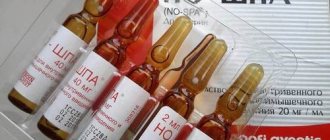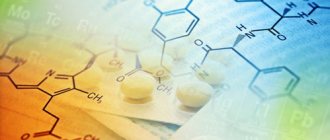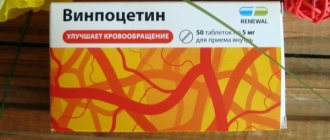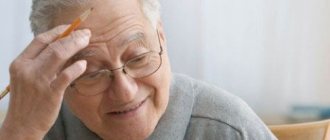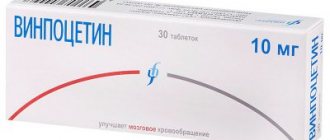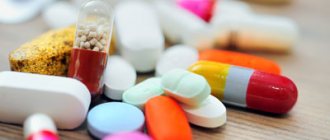Medicines to preserve memory in an elderly person, medicines to improve memory in the elderly, medicines to treat forgetfulness in the elderly are a hot topic. All medications for improving and preserving memory in old age can be divided into 4 categories: medications, dietary supplements, vitamins and nootropics. And all drugs have psychotropic functions, not mnemotropic ones - that is, they activate the capabilities of the psyche, and not memory, as they affect blood circulation and processes that activate attention, perception, and concentration. But they do not directly affect memory. So, unfortunately, any of the existing medications is not a pill that helps you “remember everything.” So let's just talk about those medications that activate cerebral circulation, which improves memory and activates it.
Phenylpiracetam
Phenylpiracetam is one of the most effective nootropic drugs with noticeable psychostimulating, anticonvulsant, and neuromodulatory effects. For older people, it is important to use the drug as part of complex therapy for diseases of the central nervous system, which are associated with deterioration of intellectual and mental functions: the ability to concentrate, remember, and learn. Can be used as a prophylaxis against hypoxia in diseases of the heart or respiratory system. Slows down the decline in psychomotor activity, reduces lethargy and increased exhaustion.
Coluracetam
999 rub.
Phenylpiracetam should be taken with caution by people suffering from kidney disease, atherosclerosis and arterial hypertension.
"Noopept"
This is a modern nootropic medicine developed by Russian scientists. The drug has a complex effect, improves blood microcirculation and brain functioning.
In addition, Noopept helps restore memory and attention, eliminate dizziness, improve well-being, and promote good sleep. According to the instructions and reviews, the memory medicine for the elderly has a special spectrum of action:
- Nootropic effect - restores memory and, unlike its generics, directly affects three stages of memory: memorization, storage, reproduction.
- Antioxidant effect – the drug protects against the effects of free radicals.
- Neuroprotective effect - the medicine protects brain cells. The neuroprotective effect of Noopept is due to the fact that under the influence of the active component in the brain, resistance to various damaging factors increases.
- Improves nutrition and blood microcirculation.
The innovative drug improves memory, as well as attention, learning, and performance. In addition, it normalizes sleep and improves mood. Which medicine is most suitable for improving memory for older people?
DMAE
DMAE is a naturally occurring molecule found in fish. Human studies since the 70s have shown that taking DMAE increases life expectancy.
DMAE is a precursor to the memory molecule acetylcholine and the molecule that is part of cell membranes, phosphatidylethanolamine.
Additional intake of the supplement improves memory functions and increases the “fluidity” of cell membranes. For example, this makes it easier for red blood cells to bend when passing through small capillaries.
DMAE is an antioxidant and is capable of removing the “aging pigment” lipofuscin that accumulates in cells, which interferes with the normal functioning of cells.
DMAE
399 rub.
"Aminalon"
A nootropic medicine that has a moderate psychostimulating effect. "Aminalon" has a number of positive effects:
- Enhances energy processes in neurocytes.
- Improves memory, mental performance, concentration.
- Has a mild psychostimulating effect.
- Helps stabilize blood pressure in hypertension.
- Has an anticonvulsant effect.
Minuses:
- Side effects, contraindications.
- Strengthens the effect of benzodiazepines, as well as hypnotics and anticonvulsants.
Herbal nootropics for the elderly
A huge variety of plants have nootropic properties. This was known earlier, but until recently it had no confirmation at the level of scientific research.
Nootropic drugs of natural origin have a gentler effect on the body. That is why they are recommended for use in the case of a large number of contraindications that make the use of racetams undesirable.
Herbal nootropics from Mr.Lt. Nootropics comes in two forms: tablets and powder. The cost of drugs in powder form is significantly lower than that of existing pharmacy analogues.
"Piracetam"
A nootropic drug that helps restore and stabilize brain functions, and also has a moderate anticonvulsant effect. Minuses:
- An old medicine, one of the very first.
- There are many adverse reactions and contraindications.
- Not compatible with Thyroxine, Triiodothyronine.
Ginkgo biloba
Ginkgo biloba is the most famous herbal nootropic in our area. It is often prescribed for problems associated with poor circulation of the brain and tinnitus.
Ginkgo extract normalizes dopamine levels and reduces the level of cortisol, the slow stress hormone.
Ginkgo biloba contains the substance quercetin in large quantities. Research confirms its high antioxidant effect, neuroprotective and anti-inflammatory effects. Taking the drug also helps reduce blood pressure in hypertensive patients.
Ginkgo biloba
329 rub.
In fact, the effects of Ginkgo biloba on people over 40 can be described as:
- reducing the likelihood of developing cardiovascular diseases,
- weakening of weather sensitivity,
- elimination of periodic headaches, if they were associated with spasms of the vessels of the meninges,
- General increase in tone, cheerfulness and subjective feeling of well-being.
As an additional supplement, taking ginkgo is effective in the treatment of atherosclerosis, diabetic nephropathy, and glaucoma. There are positive data on use for multiple sclerosis, senile dementia, and tardive dyskinesia.
Taking vitamins in old age
In the body of older people, there is often a lack of vitamins involved in metabolic processes. Therefore, when memory problems are detected, doctors recommend taking vitamin complexes with herbal supplements (for example, ginseng), since they have a nootropic effect. It is especially important for older people to drink vitamins A and B and ascorbic acid. But old people often simply forget to drink the medicine due to memory problems. Therefore, it is better to choose a complex that combines daily doses of all the necessary vitamins and supplements that improve the nutrition of brain cells and their functioning.
What brain medications can a doctor prescribe for older people? Pensioners are often prescribed medications containing glycine, an amino acid involved in the metabolic processes of various organs of the body. Indications for the use of medicine for cerebral vessels for elderly people are memory impairment, detection of atherosclerotic changes in blood vessels and amnesia.
Thanks to the tablets, metabolic processes are normalized, as a result, performance and brain activity increase, sleep is normalized, and anxiety states disappear. The advantage of such drugs is a small number of side effects. This is due to the fact that glycine is a natural substance for the body. It is extremely rare that an elderly person may develop an allergy to the drug or an individual intolerance to it. In some cases, we are talking only about mild drowsiness at first.
We recommend
“How to care for a bedridden elderly person” Read more
Gotu kola
This little-known plant in the CIS countries has remarkable effects: it has an anti-inflammatory effect and has a positive effect on joint health.
Drinking gotu kola improves the condition of the skin, accelerates the healing of wounds and burns, and strengthens joints and ligaments. In addition, the extract has nootropic effects: promotes brain restoration after injuries, strokes, stress; reduces anxiety and other symptoms of depression.
Gotu Kola + Ginkgo biloba
399 rub.
"Vinpocetine"
Corrects microcirculation disorders in the brain and also improves metabolism. Helps utilize glucose.
The active component has a positive effect on the functioning of the central nervous system:
- Improves cerebral circulation.
- Ischemic areas are well nourished.
- Increases efficiency and attention.
When treated with a drug to improve memory, older people noted an improvement in their overall health, as well as a decrease in the frequency of headaches.
Under the influence of Vinpocetine, the connection of blood clots worsens and an improvement in blood properties is observed. The active component activates the supply of oxygen and glucose to brain tissues, and also serves as a prophylactic to prevent the development of ischemia and has a pronounced antioxidant effect.
Proper nutrition
One of the main aspects for maintaining brain function in old age is nutrition. It is necessary to eat only healthy foods that contain the vitamins and minerals necessary for proper brain function.
Most of all, the brain needs useful components that improve its functioning, these are products containing vitamins B and K, as well as ascorbic acid, tocopherol, Omega-3, iodine, selenium, phosphorus, boron.
Some of the healthiest foods for better brain function are:
- Fruits.
- Beef.
- Liver.
- Sea fish.
- Vegetables.
- Nuts.
- Olive oil.
- Honey.
"Picamilon"
A nootropic drug that corrects cerebral circulation. "Picamilon" has an antioxidant, as well as tranquilizing and psychostimulating effect.
The drug helps dilate the blood vessels of the brain. The tablets have soothing, antiplatelet and antioxidant properties.
The active component of the drug improves brain functioning:
- increases concentration;
- improves mental activity, memory;
- helps stabilize cerebral circulation and saturate brain tissue with oxygen.
Prescribe medication for memory loss to an elderly person to normalize sleep, eliminate anxiety and fear, and improve memory.
Alternative Treatments
In addition to drug treatment, it is necessary to use other methods to improve memory so that the therapy is comprehensive.
You need to pay attention to your diet, as well as physical exercise and creating a favorable psychological environment around. An important point is to get enough sleep at night, as well as walks in the fresh air.
To train your memory, you can use the following techniques:
- read and retell texts more;
- memorize poetry;
- carefully study the details of the environment;
- learn to play musical instruments.
Causes of pathology
Circulatory dysfunction occurs when, when the blood vessels narrow, the required volume of blood does not reach the brain, the cells do not receive oxygen, hence the ensuing symptoms of the pathology:
Advertising:
- psychoses;
- dementia;
- depression;
- insomnia;
- headache;
- mood swings;
- memory losses;
- decreased motor activity.
Memory impairment in the elderly
P
Increased forgetfulness is one of the most common complaints in elderly patients. Memory loss in old age can be both a consequence of physiological age-related changes in the central nervous system and a pathological symptom of a number of brain diseases. Therefore, a careful analysis of the nature of mnestic disorders is of great importance for the early diagnosis of neurogeriatric diseases and the selection of the correct tactics for patient management.
Physiological changes in memory
Numerous experimental psychological studies are consistent with everyday observations that older people learn new information worse than young people. Age-related difficulties in the mnestic sphere usually arise when handling large amounts of information or when working simultaneously with several sources of information. This may make it somewhat difficult for older people to learn new skills and requires a more strict external organization of professional activities (for example, the use of notebooks, schedules, etc.). At the same time, physiological forgetfulness never extends to current or distant life events, as well as general knowledge acquired in young or middle age. The presence of amnesia for current events, partial loss of professional or everyday competence is always a pathological sign indicating the onset of a brain disease [5,29,31,43].
Memory decline in old age is combined with a number of other changes in cognitive functions
. The latter relate primarily to reaction time, which tends to increase with age [29,31]. As a result, older adults take longer to perform the same amount of mental work than younger adults. Fatigue during mental exercise in old age also develops somewhat faster than in young people. Obviously, these phenomena are based on “neurodynamic” (in the terminology of A.R. Luria) changes in higher nervous activity, that is, a decrease in the activating influences on the cerebral cortex from nonspecific activating cerebral structures [8–11].
Physiological age-related changes in cognitive functions, according to neuropsychological research methods, occur between the ages of 40 and 65 years. Age-related changes in cognitive functions are non-progressive: thus, according to F. Huppert and M. Koppelman, healthy individuals over 65 years of age are not inferior in memory performance to individuals in the age range of 55–65 years, but both are significantly inferior to those aged twenty [39]. It is assumed that physiological changes in higher brain functions are based on changes in cerebral metabolic processes associated with hormonal changes [39,43].
In everyday medical practice, distinguishing between normal and pathological changes in cognitive functions is often a very serious problem. An attempt at a neuropsychological approach to this problem consists in the use of special techniques that stimulate the attention of patients at the memorization stage. For example, the patient is asked to sort the presented words into semantic groups (plants, animals, etc.), and then the name of the group is used as a hint for reproduction (methodology by Grober and Buschke, 1988). It is believed that in the presence of only physiological memory decline, such stimulation of attention equalizes the performance of elderly and young people [27,35,36]. It should also be noted that visually presented information is remembered in old age better than auditory-speech information [29].
However, with relatively mild pathological forgetfulness (for example, in the earliest stages of organic brain damage), neuropsychological research methods can give false-negative results. Therefore, from a practical point of view, active complaints of forgetfulness should always be considered a pathological symptom. However, this symptom can be both organic and functional (psychogenic) in nature, which requires additional consideration.
Memory impairment due to organic brain damage
Most often, progressive memory loss in old age is a manifestation of Alzheimer's disease.
(BA). AD is one of the most common neurogeriatric diseases of a degenerative nature. According to statistics, this disease underlies at least half of the cases of dementia in the elderly and is observed in 5–10% of people over 65 years of age [19].
The risk of developing asthma is primarily due to genetic factors. The presence of cerebrovascular insufficiency and a history of traumatic brain injury are also considered pathogenetic factors. In typical cases, the first symptoms of the disease appear at the age of about 70 years and affect the mnestic sphere. Common complaints from patients: the inability to remember what they just read or saw on TV, the names of new acquaintances, difficulty finding the right word in a conversation. Forgetfulness is progressive in nature and at advanced stages of the disease it spreads to life events: first of the immediate past, and then of the more distant one (Ribault’s law). Advanced stages of the disease are also characterized by other cognitive disorders: difficulties in spatial orientation, counting and speech disorders [26,40,41,43,47,54].
The rate of progression of mnestic and other cognitive impairments in AD is individual. The age of onset of the disease can serve as a marker for the severity of genetic burden: the more severe the genetic defect, the earlier the disease begins and progresses faster. Therefore, presenile forms of asthma are less favorable in prognostic terms. When asthma begins in old age, disease progression may be slower. Sometimes there is a long-term stationary state of cognitive impairment, which does not exclude the diagnosis of AD [26,40,48].
Diagnosis of AD is based on the presence of dementia, the core of which is memory impairment, and the absence of clinical and neuroimaging signs of focal brain damage. At the predementia stages of the disease, when almost the only clinical manifestation is memory loss, the diagnosis, according to the recommendations of the AD Association (NINCDS-ADRDA), is formulated tentatively (“possible AD”) [48].
Another common neurodegenerative disease, dementia with Lewy bodies,
(DTL). DLB is related to AD in genetic, neurochemical and pathomorphological terms. The distinctive clinical signs of this disease are the motor symptoms of parkinsonism and the early development of neuropsychiatric disorders in the form of recurrent visual hallucinations. In some cases, motor or psychotic disorders may come to the fore of the clinical picture, overshadowing relatively mild or moderate mnestic and other cognitive disorders [49].
In contrast to AD or DLB, memory impairment with vascular lesions of the brain as part of discirculatory encephalopathy
(DE) are presented more modestly. In typical cases, DE is characterized predominantly by a “subcortical” type of cognitive impairment. This is due to the fact that the basal ganglia and deep parts of the medulla are the zone of “terminal blood supply” and are therefore most vulnerable to insufficiency of cerebral blood flow [4,13,14,17,38]. “Subcortical” dementia is characterized primarily by slowness of cognitive processes and dysregulation of voluntary activity in the form of inactivity, inertia, perseveration and impulsive behavior [18,32]. It should be noted that the term “subcortical” dementia itself is not accurate, since these symptoms have a “cortical” pathogenesis associated with dysfunction of the frontal regions of the brain [16]. The latter probably arises as a result of deafferentation of the frontal cortex due to disruption of frontostriatal connections [14,17,38].
Memory impairments in DE, as in other “subcortical dementias,” are secondary in relation to dysregulatory disorders. They are based on insufficient activity and disturbances in the planning of mnestic activity. Memory impairments in this case, as a rule, are obvious only when using neuropsychological research methods, but do not extend to current life events [4,14,17,18,32].
Often vascular damage to the brain is combined with neurodegenerative changes
. The incidence of “mixed” (vascular degenerative dementia) is at least 20%, which is significantly higher than expected from a random combination of two diseases. Experimental observations are consistent with clinical ones and indicate that cerebral vascular insufficiency is the unfavorable background that accelerates the clinical implementation of genetic predisposition to AD. Therefore, among people with vascular diseases of the brain, the incidence of asthma is higher than in the population [40,47].
Dysmetabolic disorders
as a result of somatic or endocrine disease,
nutritional disorders, intoxication
can also cause memory and attention disorders in old age or can aggravate disorders associated with structural brain damage. Among the dysmetabolic causes of cognitive disorders, the most important to note are hypothyroidism, liver failure, chronic hypoxemia as a result of respiratory failure or sleep apnea, deficiency of cyanocobalamin and folic acid, abuse of alcohol and psychotropic drugs.
Functional memory disorders
Complaints of memory loss are a typical symptom of anxiety and depressive disorders. Mental disorders of anxiety and depression are the most common cause of increased forgetfulness in young and middle age, when organic memory disorders are rare. In old age, both functional and organic memory impairments are quite expected, and their combinations are often encountered [47]. This is due to the high prevalence of depression in the elderly. The latter has both organic and situational prerequisites. We are talking, on the one hand, about involutive changes in neurotransmitter systems, and on the other hand, about changes in social status, loss of close relatives, and the occurrence of chronic diseases, which often occurs in old age. In addition, depression can be a manifestation (sometimes the debut) of organic brain damage, for example, Parkinson's disease, dementia with Lewy bodies, cerebrovascular insufficiency, etc.
Memory impairments in anxiety-depressive disorders are most often explained in psychodynamic terms. It is assumed that the basis for insufficient memorization is the inability to switch attention from current psychological experiences to solving current cognitive problems. The inability to concentrate on everyday problems can be so severe that the patient ceases to cope with his professional and everyday responsibilities (“pseudo-dementia”). However, objective disturbances of mnestic function, according to neuropsychological research methods, are absent or minimally expressed and cannot explain the degree of maladjustment. Memory impairments, as a rule, do not affect emotionally charged events. Anxiolytics, in particular benzodiazepines, improve memory and recall of information
. This is due to the secondary nature of mnestic disorders in relation to anxiety, since according to their pharmacological properties, benzodiazepines, on the contrary, weaken the processes of registration and consolidation of the memory trace [33,43,47].
The functional nature of memory disorders can be judged on the basis of the above-mentioned features of mnestic disorders and their combination with other symptoms of anxiety and depression. It should, however, be noted that the presence of depression does not mean the absence of organic brain damage. On the contrary, as already noted, emotional disorders are typical of many organic diseases of the central nervous system.
Principles for the management of memory impairment in the elderly
Complaints about memory loss in old age require, first of all, the objectification of cognitive impairment. For this purpose, neuropsychological research methods
. The following methods are the easiest to use and very informative: a brief study of mental status, a clock drawing test, the Grober and Buschke technique in various modifications, memorization and retelling of a short text (for example, “Jackdaw and Doves” according to the method of A.R. Luria) [5 ,8,36,37,46]. To assess the extent of the impact of cognitive disorders on everyday life, a conversation with the patient’s relatives or his colleagues is necessary. If there is objective evidence of cognitive impairment and changes in daily lifestyle as a result of the latter, a diagnosis of dementia is legitimate. It is important to note that when making a diagnosis of dementia, one should not wait for the patient to become severely maladjusted. According to current guidelines, the presence of clinically significant deterioration in cognitive function that affects daily life is a sufficient basis for the diagnosis of dementia [12,20].
If there are complaints of forgetfulness, but minimally expressed objective cognitive impairment, as well as in the absence of changes in the usual lifestyle, the diagnosis, according to the ICD-10 recommendations, can be formulated as “mild cognitive impairment” [12].
Treatment of cognitive impairment
both at the stage of mild cognitive impairment and at the stage of dementia, should, if possible, be etiotropic or pathogenetic. However, in all cases the following measures are advisable:
– correction of dysmetabolic disorders
, which may cause or aggravate existing mnestic disorders. In some cases, it may be advisable to prescribe ex juvantibus therapy with cyanocobalamin and folic acid. It is important to note that with timely diagnosis and treatment, cognitive impairment of a dysmetabolic nature is reversible;
– treatment of diseases of the cardiovascular system
. As noted above, vascular damage to the brain has pathogenetic significance both in dyscirculatory encephalopathy and in neurodegenerative diseases. Therefore, control of arterial hypertension, hyperlipidemia, administration of antiplatelet agents and other known measures are the pathogenetic treatment of most cases of dementia;
– depression treatment
. In the presence of emotional disorders, psychotherapy and psychopharmacotherapy for depression are mandatory measures, regardless of whether cognitive impairment is only psychogenic or emotional disorders are secondary to organic brain damage. In the treatment of depression in elderly people with memory impairment, drugs with anticholinergic properties, such as tricyclic antidepressants, should be avoided. Selective serotonin reuptake inhibitors are more appropriate.
An accurate nosological diagnosis for dementia is based on a thorough analysis of anamnestic, clinical and neuropsychological data, as well as neuroimaging data. To select the optimal treatment, both the nosological affiliation and the severity of dementia, the presence of emotional disorders and other features of the case are important.
For mild or moderate dementia in AD and DLB, acetylcholinesterase inhibitors
. Today, there is the largest evidence base regarding the effectiveness of drugs in this group. Acetylcholinesterase inhibitors are effective both against memory impairment and other cognitive functions, and against neuropsychiatric symptoms such as sleep disturbances, hallucinations and delusions. The constant use of drugs of this pharmacological group contributes to a significant increase in the length of time of relative functional independence of patients with asthma. The widespread use of these drugs is somewhat limited by dyspeptic side effects associated with excessive cholinergic activity. In the presence of depression, these drugs can aggravate its manifestations [1,3,7,21,24,25,28,30,42,44,45,53].
Recent controlled studies in North America, Europe, and Southeast Asia suggest that the peptidergic drug cerebrolysin
, when administered intravenously in a dose of at least 30 ml, 20 infusions per course, has a beneficial effect on cognitive functions, possibly not inferior to the effect of acetylcholinergic drugs. The advantageous aspects of using Cerebrolysin include its effectiveness not only in neurodegenerative but also in vascular dementia, good tolerability, and a possible neuroprotective effect [2,5,15,22,34,51].
Glutamatergic drug memantine
has a beneficial effect on cognitive functions in AD, as well as in vascular and mixed dementia. According to some data, the symptomatic effect of memantine is more pronounced in more advanced stages of dementia. The neuroprotective effect of the drug is also discussed, associated with a decrease in glutamate-mediated excitotoxicity in relation to acetylcholinergic neurons [50,52].
Standardized preparation of Ginkgo extract (Tanakan)
, with its constant use, contributes to a slower progression of the neurodegenerative process due to its antioxidant properties, the ability to activate the metabolism of brain neurons, improve the rheological properties of blood and microcirculation. The main active ingredients of Tanakan are flavonoid glycosides, terpene substances (ginkgolides A, B, C, bilobalide) and proanthocyanidins. These substances have a multidirectional positive effect on the processes of free radical oxidation, tissue metabolism and microcirculation. Under experimental conditions, it was shown that Tanakan affects neurotransmitter processes in the central nervous system. This is demonstrated by its ability to enhance the release of neurotransmitters from presynaptic nerve terminals, inhibit the reuptake of biogenic amines, and enhance the sensitivity of postsynaptic muscarinic receptors to acetylcholine. All of the above determines the advisability of using Tanakan in the complex treatment of memory and attention disorders in elderly patients [6, 23].
At the stage of mild cognitive disorders that do not reach the stage of dementia, an accurate nosological diagnosis is not always possible due to the insignificance of neuropsychological symptoms, sometimes only the subjective nature of the disorders. Often, in order to verify the pathological nature of the disorders and clearly determine the nosological affiliation of the case, long-term observation of the patient is necessary. However, the lack of complete confidence in the pathological nature of the disorders and in a specific diagnosis should not be a reason for the doctor’s inaction, since it is at the stage of mild cognitive impairment that pathogenetic therapy has the greatest chance of success.
In addition to the correction of dysmetabolic disorders, treatment of vascular diseases of the brain and depression, for mild cognitive impairment it is advisable to use multimodal drugs that are effective in both degenerative and vascular diseases of the brain and have neuroprotective properties. Today there is positive experience in conducting repeated courses of intravenous infusions of Cerebrolysin
(30–60 ml per 200 ml of saline intravenously, 20 infusions per course, 2 courses per year) and many months (possibly many years) of taking
Tanakan
(40–80 mg three times a day) [6,15].
The question of the advisability of memory training in old age is very controversial. To date, there is no evidence that memory training can prevent or slow the progression of neurodegenerative or vascular disease of the brain. However, with the stationary nature of the disorders, teaching the patient to use certain memorization strategies and increasing the level of attention undoubtedly helps to increase the effectiveness of mnestic activity.
Thus, memory impairment in old age is one of the most pressing medical and social problems.
The use of modern diagnostic methods and pharmacotherapy can significantly improve the quality of life of elderly people with cognitive disorders, extend the time of functional independence, and reduce the economic and social burden that falls on patients’ relatives and society as a whole. Literature:
1. Bukatina E.E., Grigorieva I.V., Sokolchik E.I. Efficacy of amiridine in the early stages of Alzheimer's disease. //J.neuropathol. and a psychiatrist. –1991. –T.91., No. 9. –P.53–58.
2. Vereshchagin N.V., Lebedeva N.V. Mild forms of multi-infarct dementia: the effectiveness of Cerebrolysin. //Sov.Med. –1991. –No.11. –P.6–8.
3. Groppa S.V. Drug correction of Alzheimer's disease. // Journal of Neuropathology and Psychiatry. –1991. –T.91. –No. 9. –P.110–116.
4. Damulin I.V., Yakhno N.N. Cerebrovascular insufficiency in elderly and senile patients (clinical computed tomography study). // Journal of Neuropathology and Psychiatry. –1993. –T.93. –N.2. –P.10–13.
5. Zakharov V.V., Damulin I.V. Diagnosis and treatment of cognitive impairment in the elderly. //Guidelines. Edited by N.N. Yakhno. –Moscow: MMA im. I.M. Sechenov. –2000.
6. Zakharov V.V. Application of tanakan in neurogeriatric practice. // Neurological journal. –1997. –T.5. –P.42–49.
7. Zakharov V.V., Damulin I.V., Yakhno N.N. Drug therapy for dementia. //Clinical pharmacology and therapy. –1994. –T.3. –No. 4. –S. 69–75.
8. Luria A.R. Higher cortical functions of humans. //Moscow: Moscow State University Publishing House. –1969.
9. Luria A.R. Fundamentals of neuropsychology. //Moscow: Moscow State University Publishing House. –1973.
10. Luria A.R. Neuropsychology of memory. Memory impairment due to local brain lesions. //Moscow: Pedagogy. –1974.
11. Luria A.R. Neuropsychology of memory. Memory impairment in deep-seated brain lesions. //Moscow: Pedagogy. –1976.
12. International statistical classification of diseases and health-related problems. Tenth revision. (ICD-10). //–Geneva, WHO. –1995.
13. Shmidt E.V. Classification of vascular lesions of the brain and spinal cord. //AND. Neuropathology and Psychiatry. –1985. –T.85. –pp.192–203.
14. Yakhno N.N., Levin O.S., Damulin I.V. Comparison of clinical and MRI data in dyscirculatory encephalopathy. Message 2: cognitive impairment. //Nevrol.zhur. –2001. –T.6, No. 3. –P.10–19.
15. Yakhno N.N., I.V.Damulin, V.V.Zakharov, O.S.Levin, M.N.Elkin. Experience with the use of high doses of Cerebrolysin in vascular dementia. // Ter Archive. –1996. –T.68. –No. 10. –P.65–69.
16. Yakhno N.N. Current issues in neurogeriatrics. //On Sat. N.N. Yakhno, I.V. Damulin (eds.): Advances in neurogeriatrics. -Moscow. –1995. –Part 1. –P.9–29.
17. Yakhno N.N., Damulin I.V., Bibikov L.G. Chronic cerebrovascular insufficiency in the elderly: Clinical and computed tomographic comparisons. //Clinical gerontology. –1995. –N.1. –P.32–36.
18. Albert ML Subcortical dementia. In: Alzheimer's disease: Senile Dementia and Related Disorders. –New York, Raven Press, 1978, V.7, pp. 173–180.
19. Amaducci L., L. Andrea. The epidemiology of the dementia in Europe.//In A. Culebras, J. Matias Cuiu, G. Roman (eds): New concepts in vascular dementia. –Barseleona: Prouse Science Publissher. –1993. –P.19–27.
20. American Psychiatric Association. Diagnostic and statistical manual of mental disorders. 4th ed. –Washington: American Psychiatric Association. –1994.
21. Anand R., Hartman R., Gharabawi G. Worldwide clinical experience with Exelon, a new generation of cholinesterase inhibitor in the treatment of Alzheimer's disease. //Eur J Neurol. –1997. –Vol.4, Suppl.1.–PS37.
22. Bae CY, Cho CY, Cho K. Et al. A double–blind placebo controlled, multicenter study of Cerebrolysin in Alzheimer's disease. //J Am Geriatr Soc. –2000. –Vol.48. –P.1566–1571.
23. Bars P., Katz M., Berman N., Itil T., Freedman A., Schatzberg A. A placebo-controlled, double-blind, randomized trial of an extract of ginkgo biloba for dementia. // JAMA. – 1997. –Vol.278, N.16. –P.1327–1332.
24. Bartus RT Drug to treat age related neurodegenerative problems. //J Am Ger Soc. –1990. –V.38. –P.680–695.
25. Beatty WW, N. Butters, DS Janowsky. Patterns of memory failure after scopolamine treatment: implication for cholinergic hypotesis of dementia. //Behav Neural Biol. –1986. –V.45. –P.196–211.
26. Becker JT, FJHuff, RDNebes et al. Neuropsychological function in Alzheimer's disease: pattern of impairment and rates of progression. //Arch Neurol. –1988. –V.45. –No. 3. –P.263–268.
27. Bushke H, E.Grober. Genuine memory deficit in age associated memory impaiment. //Dev Neuropsychol. –1986. –V. 2. –P.287–307.
28. Chrisensen, N. Malty, AFLorn et al. Cholinergic 'blockade' as a model of the cognitive deficit in Alheimer's disease. //Brain. –1992. –V.115. –P.1681–99.
29. Ciocon JO, JFPotter. Age–related changes in human memory: normal and abnormal. //Normal and Abnormal Geriatrics. –1988. –V.43. –N.10.–P.43–48.
30. Claus JJ, C. Ludvig, E. Mohr et al. Nootropic druds in Alzheimer's disease. //Neurology. –1991. –V.41. –P. 570–574.
31. Crook TH, R. Bartus, S. Ferris et al. Age Associated memory impairment. Proposed diagnostic criteria and measures of clinical change. //Dev Neuropsychol. –1986. –V.2. –P.261–276.
32. Cummings JL Subcortical dementia. //New York: Oxford Press. –1990.
33. Сurran HV Benzodiazepines, memory and mood: a review. //Psychopharmacology. –1991. –V. 105. –P.1–8.
34. Gauthier S. Results of a 6–month randomized placebo–controlled study with Cerebrolysin in Alzheimer's disease. //Eur J Neurol. –1999. –Vol.6, suppl.3. –P.28.
35. Grober E., H. Buschke. Genuine memory deficit in dementia. //Dev Neuropsychol. –1987. –V.3. –P.13–36.
36. Grober E., H. Buschke, H. Crystal et al. Screening for dementia by memory testing. //Neurology. –1988. –V.38. –P.900–903.
37. Folstein MF, SEFolstein, PRMcHugh. Mini–Mental State: a practical guide for grading the mental state of patients for the clinician. // J Psych Res. –1975. –V.12. –P.189–198.
38. Hershey LA, Olszewski WA Ischemic vascular dementia. //In: Handbook of Demented Illnesses. Ed. by JCMorris. –New York etc.: Marcel Dekker, Inc. –1994. –P.335–351
39. Huppert FA, MDKopellman. Rates of forgetting in normal aging: a comparison with dementia. //Neuropsychology. –1989. –V.27. –No. 6. –P.849–60.
40. Iqbal K., B. Winblad, T. Nishumura, N. Takeda, H. Wishewski (eds). Alzheimer's disease: biology, diagnosis and therapeutics. //J.Willey and sons ltd. –1997.
41. Karlsson T., L. Backman, A. Herlitz et al. Memory improvement at different stages of AD. //Neuropsychol. –1989. –V. 27. –No. 5. –P.737–42.
42. Kopelman MDand THCorn. Cholinergic 'blockade'as a model for cholinergic depletion. //Brain. –1988. –V.111. –P.1079 – 1110.
43. Kopelman MD Amnesia: organic and psychogenic. //Br J Psych. –1987. –V.150. –P.428–442.
44. Kopelman MD The cholinergic neurotransmitter system in human memory and dementia: a review. //Quart J Exp Psychol. –1986. –V.38. –P.535–573.
45. Kumor V., M. Kalach. Treatment of Alzheimer's disease with cholinergic drugs. //Int J Clin Pharm Ther Toxicol. –1991. –V.29. –No. 1. –P.23–37.
46. Lezak MD Neuropsychology assessment. //NY University Press. –1983. –P.768.
47. Lovenstone S., Gauthier S. Management of dementia. London: Martin Dunitz, 2001.
48. McKahn G., D. Drachman, M. Folstein et al. Clinical diagnosis of Alzheimer's disease: Report of NINCDS ADRDA Working group under the audits of the Department of Health and Human Services Task Force on Alzheimer's disease. //Neurology. –1984. –V.34. –P.939–944.
49. Perry R., I. McKeith, E. Perry. Dementia with Lewy bodies. clinical, pathological and treatment issues. //Cambridge University Press. –1996. –P.510.
50. Reisberg B., Windscheif U., Ferris S. et al. Memantine in moderately severe to severe Alzheimer's disease: results of placebo–controlled 6 month trial. //Neurobiol Aging. –2000. –Vol.21. –P.S275.
51. Ruther E., Ritter R., Apecechea M. et al. Sustained improvement in patients with dementia of Alzheimer's type (DAT) 6 months after termination of Cerebrolysin therapy. //J Neural Transm. –2000. –V.107. –P.815–829.
52. Sahin K., Stoeffler A., Fortuna P. Et al. Dementia severity and the magnitude of cognitive benefit by memantine treatment. A subgroup analysis of two placebo–controlled clinical trials in vascular dementia. //Neurobiol.Aging. –2000. –Vol.21.–P.S27.
53. Sarter M. Taking stock of cognitive enhancers. //Trends Pharm Sci. –1991. –V.12. –No. 12. –P.456–461.
54. Wilson RS, AWKasniak, JHFox. Remote memory in senile dementia. //Cortex. –1981. –V.17. –P.41–48.
